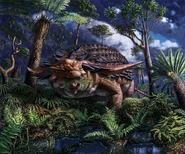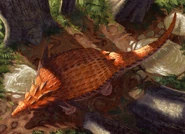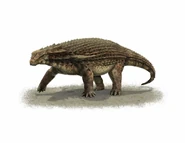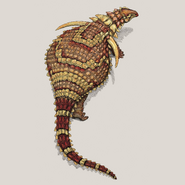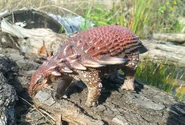| Borealopelta | |
|---|---|
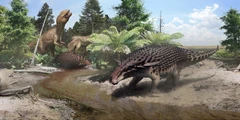
| |
| Robert Nicholls' illustration of B. markmitchelli | |
| Scientific classification | |
| Kingdom: | Animalia |
| Phylum: | Chordata |
| Class: | Sauropsida |
| Clade: | Dinosauria |
| Family: | Nodosauridae |
| Genus: | †Borealopelta Brown, 2017 |
| Species: | †B. markmitchelli |
| Type species | |
| †Borealopelta markmitchelli Brown, 2017 | |
Borealopelta (meaning "Northern shield") is a genus of nodosaurid ankylosaur from the Early Cretaceous of Alberta, Canada. It contains a single species, B. markmitchelli, named in 2017 by Caleb Brown and colleagues from a well-preserved specimen known as the Suncor nodosaur.
Description[]
Borealopelta was measured to be 5.5 meters in length and 1.3 tonnes in weight.
The Suncor Borealopelta is remarkable for its three-dimensional preservation of a large, articulated dinosaur complete with soft tissue. While many small dinosaurs have been preserved with traces of soft tissues and skin, these are usually flattened and compressed during fossilization. Similar-looking hadrosaurid "mummies" have a shriveled, desiccated appearance due to their partial mummification prior to fossilization. The Suncor specimen, however, appears to have sunk upside-down onto the sea floor shortly after its death, causing the top half of the body to be quickly buried with minimal distortion. The result is a specimen that preserves the animal almost as it would have looked in life, without flattening or shriveling.[1][2]
The Suncor specimen preserved numerous closely spaced rows of small armor plates, or osteoderms, lining the top and sides of its broad body. From the shoulders protruded a pair of long spines, shaped like the horns of a bull. Study of the pigments present in remnants of skin and scales suggest that it might have had a reddish-brown coloration in life, with a countershaded pattern that was used for camouflage.[2] The discovery that Borealopelta possessed camouflage coloration indicates that it was under threat of predation, despite its large size, and that the armor on its back was primarily used for defensive rather than display purposes.[1]
Discovery and Naming[]
Borealopelta was found at Millennium Mine, which is located at Fort McMurray.
Classification[]
Borealopelta belongs to the Nodosauridae family.
In popular culture[]
- Borealopelta appeared in the documentary Dinosaur Cold Case.
- Borealopelta appeared in Dino Dana the movie as fossil skeleton in the movie.
Gallery[]
References[]
- ↑ 1.0 1.1 "An Exceptionally Preserved Three-Dimensional Armored Dinosaur Reveals Insights into Coloration and Cretaceous Predator-Prey Dynamics". Current Biology. DOI:10.1016/j.cub.2017.06.071.
- ↑ 2.0 2.1 "This Is the Best Dinosaur Fossil of Its Kind Ever Found". 12 May 2017. http://www.nationalgeographic.com/magazine/2017/06/dinosaur-nodosaur-fossil-discovery/. Retrieved 31 May 2017.


